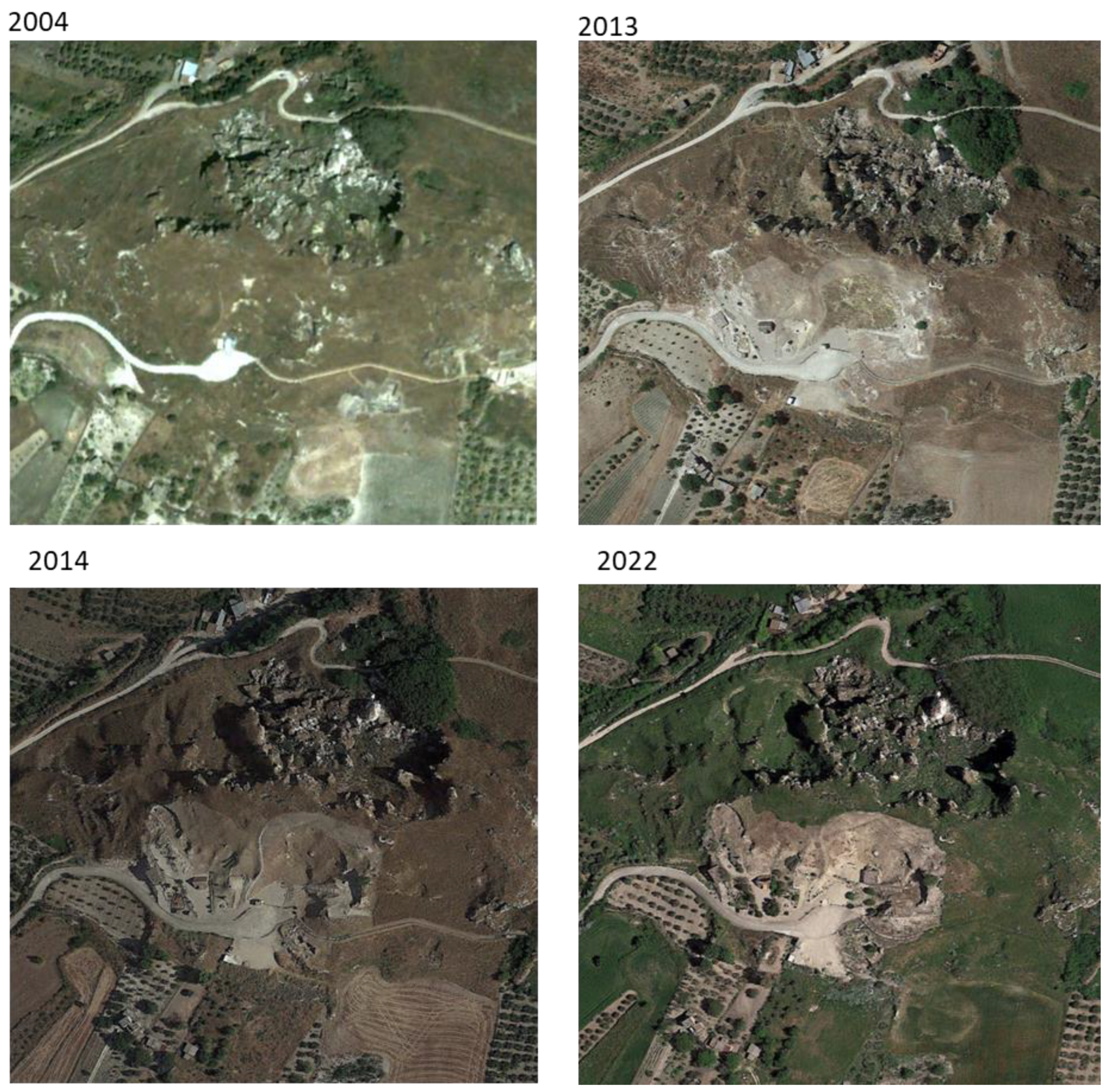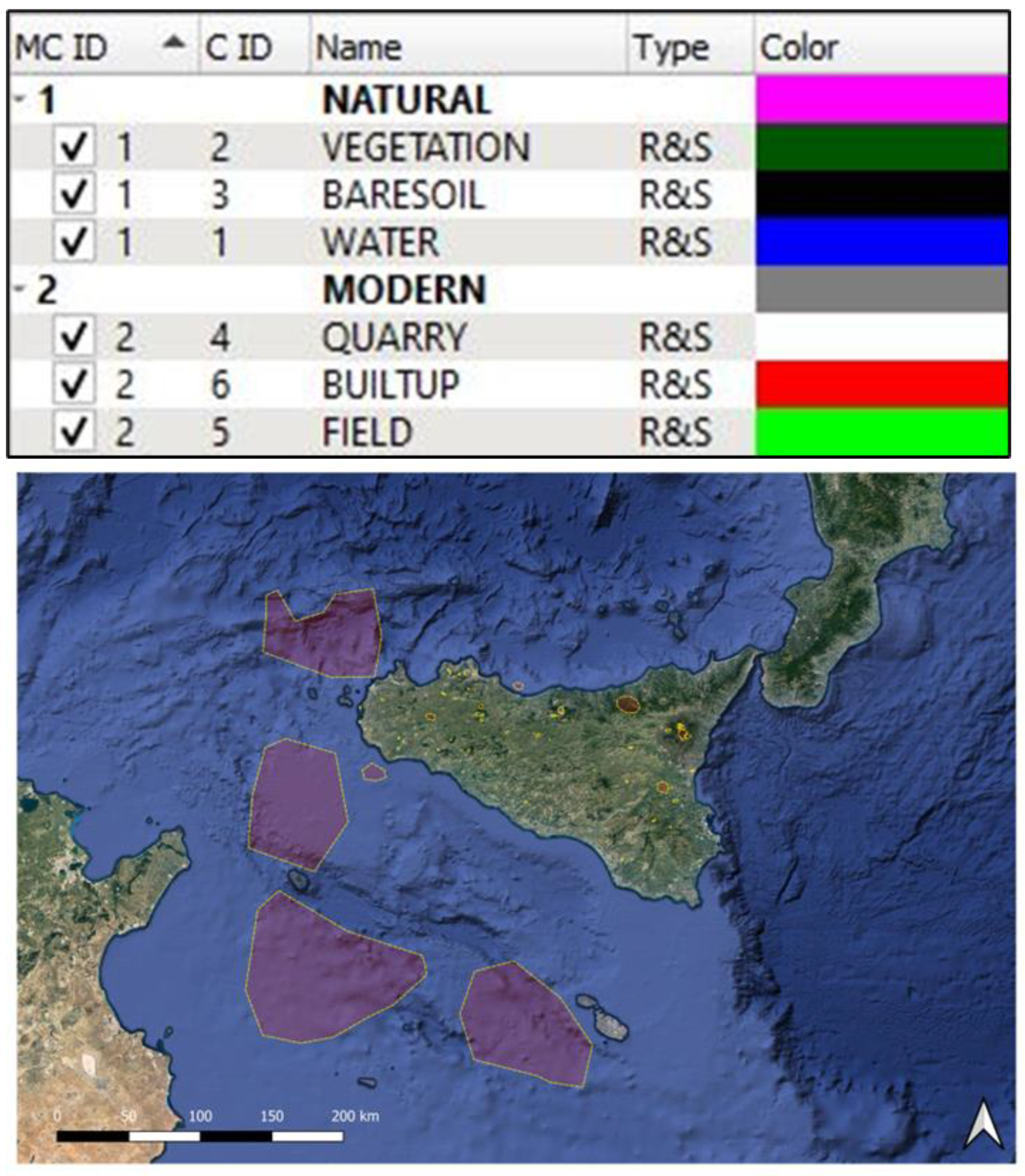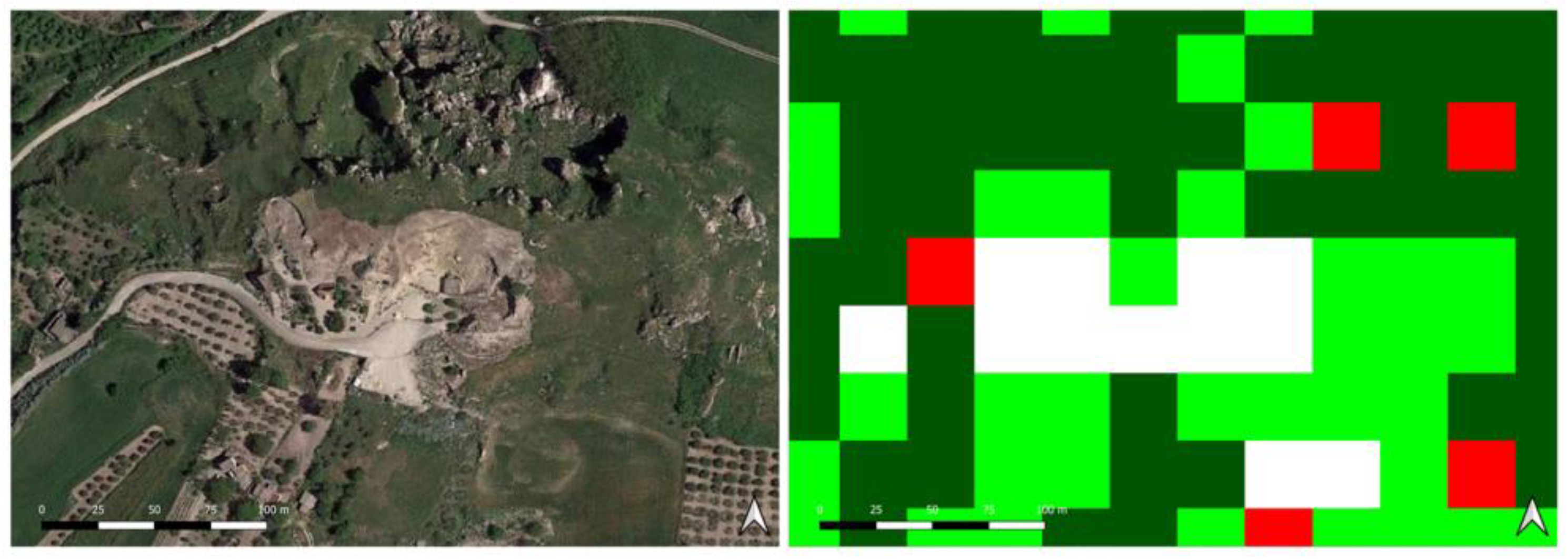Spatial Archaeology: Remote Sensing for the Study and Preservation of Cultural Heritage through Open Data and FLOSS Tools †
Abstract
:1. Introduction
2. Materials and Methods
2.1. Materials
2.1.1. Mining Activities: The Use of Google Earth
2.1.2. Satellite Imagery
- The Top-of-Atmosphere (hereafter TOA) Radiance in sensor geometry, Level-1B;
- The TOA Reflectance in cartographic geometry, Level-1C;
- The Bottom-of-Atmosphere Reflectance (hereafter BOA), Level 2A (hereafter L-2A).
2.2. Methods
2.2.1. Band Selection and Combination in GEE
2.2.2. Classification in QGIS
- One band set composed of the NIR and the OSAVI channels;
- Focused on the 6 classes;
- Number of training samples: 5000;
- Number of decision trees: 1000.
3. Results
4. Discussion and Conclusions
Author Contributions
Funding
Institutional Review Board Statement
Informed Consent Statement
Data Availability Statement
Conflicts of Interest
References
- Rayne, L.; Bradbury, J.; Mattingly, D.; Philip, G.; Bewley, R.; Wilson, A. From Above and on the Ground: Geospatial Methods for Recording Endangered Archaeology in the Middle East and North Africa. Geosciences 2017, 7, 100. [Google Scholar] [CrossRef]
- Belvedere, O. Contatto Culturale e Interrelazioni tra Greci e Indigeni nel Territorio Imerese; Centre Camille Jullian: Aix-en-Provence, France, 2010. [Google Scholar]
- Albanese Procelli, R.M.; Allegro, N.; Aquilué, X.; Archibald, Z.H.; Asensio, D.; Baralis, A.; Bats, M.; Belarte, M.C.; Belvedere, O.; Berlingò, I.; et al. Grecs et Indigènes de la Catalogne à la mer Noire: Actes des Rencontres du Programme Européen Ramses2 (2006–2008); Publications du Centre Camille Jullian, Éditions Errance: Aix-en-Provence, France, 2020; ISBN 978-2-9571557-2-9. [Google Scholar]
- Torella, G. Le Fortificazioni Indigene della Sicilia Centro-Meridionale: L’area di Influenza Geloa; Göttinger Studien zur Mediterranen Archäologie; M. Leidorf GmbH: Rahden, Germany, 2014; ISBN 978-3-86757-505-8. [Google Scholar]
- Lasaponara, R.; Danese, M.; Masini, N. Satellite-Based Monitoring of Archaeological Looting in Peru. In Satellite Remote Sensing; Lasaponara, R., Masini, N., Eds.; Remote Sensing and Digital Image Processing; Springer: Dordrecht, The Netherlands, 2012; Volume 16, pp. 177–193. ISBN 978-90-481-8800-0. [Google Scholar]
- Zhao, H.; Ma, Y.; Chen, F.; Liu, J.; Jiang, L.; Yao, W.; Yang, J. Monitoring Quarry Area with Landsat Long Time-Series for Socioeconomic Study. Remote Sens. 2018, 10, 517. [Google Scholar] [CrossRef]
- Parcak, S.H. Satellite Remote Sensing for Archaeology; Routledge: London, UK, 2009; 320p, ISBN 9780415448789. [Google Scholar]
- Congedo, L. Semi-Automatic Classification Plugin: A Python tool for the download and processing of remote sensing images in QGIS. J. Open Source Softw. 2021, 6, 3172. [Google Scholar] [CrossRef]
- Orengo, H.A.; Conesa, F.C.; Garcia-Molsosa, A.; Lobo, A.; Green, A.S.; Madella, M.; Petrie, C.A. Automated Detection of Archaeological Mounds Using Machine-Learning Classification of Multisensor and Multitemporal Satellite Data. Proc. Natl. Acad. Sci. USA 2020, 117, 18240–18250. [Google Scholar] [CrossRef] [PubMed]




| Spectral Index | Acronym | Formula |
|---|---|---|
| Difference Vegetation Index | DVI | NIR-Red |
| Disease Water Stress Index | DWSI | [NIR + GREEN]/[SWIR2 + RED] |
| Disease Water Stress Index | DWSI1 | NIR/SWIR2 |
| Disease Water Stress Index | DWSI5 | [NIR − GREEN]/[SWIR2 + RED] |
| Enhanced Vegetation Index | EVI | [NIR − RED]/[NIR + 6 × RED − 7.5 × BLUE + 1] |
| Normalized Difference Moisture Index | NDMI | [NIR − SWIR1]/[NIR + SWIR1] |
| Normalized Difference Vegetation Index | NDVI | (NIR − Red)/(NIR + Red) |
| Normalized Difference Water Index | NDWI | [GREEN × NIR]/[GREEN + NIR] |
| Optimized Soil Adjusted Vegetation Index | OSAVI | 1.5 × (NIR − Red)/(NIR + Red + 0.16) |
| Soil Adjusted Vegetation Index | SAVI | [1.5 × (NIR − RED)]/[NIR + RED + 0.5] |
Disclaimer/Publisher’s Note: The statements, opinions and data contained in all publications are solely those of the individual author(s) and contributor(s) and not of MDPI and/or the editor(s). MDPI and/or the editor(s) disclaim responsibility for any injury to people or property resulting from any ideas, methods, instructions or products referred to in the content. |
© 2024 by the authors. Licensee MDPI, Basel, Switzerland. This article is an open access article distributed under the terms and conditions of the Creative Commons Attribution (CC BY) license (https://creativecommons.org/licenses/by/4.0/).
Share and Cite
Guarino, G.; Brucato, A. Spatial Archaeology: Remote Sensing for the Study and Preservation of Cultural Heritage through Open Data and FLOSS Tools. Proceedings 2024, 96, 1. https://doi.org/10.3390/proceedings2024096001
Guarino G, Brucato A. Spatial Archaeology: Remote Sensing for the Study and Preservation of Cultural Heritage through Open Data and FLOSS Tools. Proceedings. 2024; 96(1):1. https://doi.org/10.3390/proceedings2024096001
Chicago/Turabian StyleGuarino, Giuseppe, and Alessia Brucato. 2024. "Spatial Archaeology: Remote Sensing for the Study and Preservation of Cultural Heritage through Open Data and FLOSS Tools" Proceedings 96, no. 1: 1. https://doi.org/10.3390/proceedings2024096001







